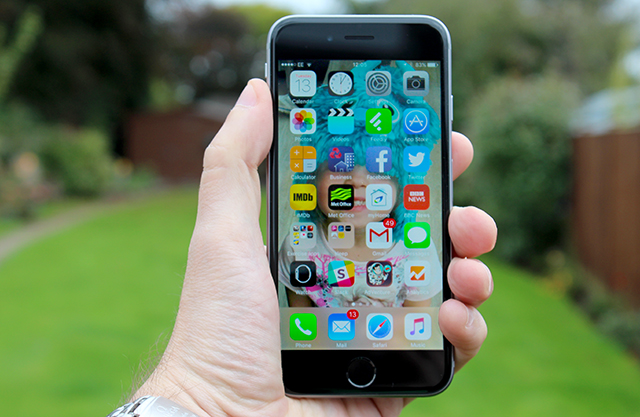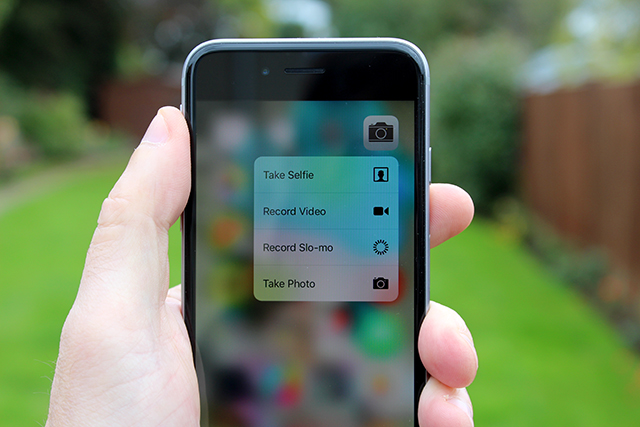
I could have reviewed Apple’s new iPhone as soon as it came out, but I preferred to wait until I’d spent a decent amount of time with the device. My initial thoughts weren’t all that favorable, thanks to a bug that affected the mobile data feature, but Apple thankfully corrected this problem fairly swiftly and that’s the only major fault I’ve encountered to date.
Apple says with the iPhone 6s, "the only thing that's changed is everything", but that’s a bit of an exaggeration seeing as the phone looks pretty much identical to its predecessor, and sports the same 4.7-inch 750x1,334 screen (326 ppi).
But while it looks exactly the same, the new phone is in fact fractionally larger (138.3mm x 67.1 mm x 7.1mm as opposed to 138.1mm x 67mm x 6.9mm) and heavier (143g vs. 129g). These differences are, of course, minimal, which means it will still fit any existing iPhone 6 cases and peripherals you might own. The 6s chassis is stronger too -- it’s made from 7000 series aluminum -- so you don’t have to worry about the device bending.
3D Touch
The big new change with the 6s is the introduction of 3D Touch, a more advanced version of Force Touch found in the Apple Watch and MacBook. This feature can determine how much pressure you’re applying to the screen, providing a whole new way of interacting with the iPhone.
3D Touch can be used in several ways. Press down hard on an icon, and if the app supports 3D Touch (most of Apple’s stock apps do, and Facebook does now as well) some options will appear. The Clock app will let you quickly set an alarm, Calendar will let you add an event, and Camera will let you take a selfie, record a video, record slo-mo, or take a photo. Photos will let you see the most recent snaps or favorites, or perform a search. Phone will let you quickly call a favorite contact, while Messages will let you resume a chat with a friend, or start a new one. A small haptic buzz tells you whenever the press has been registered, which is handy.

Another 3D Touch feature is Peek and Pop, so called because it lets you "peek" into things -- email being a great example -- without opening it, and interact with it too. Scroll down and you can reply, forward, or mark a message, get a notification or move the message. Press down harder and the pop element comes into play and opens whatever you’ve been peeking into. Peek and Pop generally works very well, although you have to learn not to press down smack bang in the center of the screen as your thumb will obscure some of what you’re peeking at.
Pressing down hard on the left screen edge of the phone brings up the app switch menu, saving you having to double tap on the home button.
3D Touch is definitely a game changer, and it will become more useful once more third-party developers add support to their apps, and find smart and inventive ways to use it. It does take a little while to get into the habit of interacting with your phone in this new way, but the feature soon becomes second nature, and once your brain is fully retrained it’s very hard to go back to using a phone that doesn’t respond to pressure in this way.
Case in point, I’ve found myself pressing down hard on the screen of my iPad Air 2 a lot recently, experiencing minor confusion every time it fails to deliver the expected response.
Camera
The iPhone 6s has a 12-megapixel rear camera, up from its predecessor’s 8-megapixels, and it’s able to cope better with a variety of different lighting situations, including low-light. The pictures it takes are unquestionably better (as well as simply bigger) than those produced by previous iPhones. The one downside of the iPhone 6s’ photographic capabilities is that it’s lacking optical image stabilization. As was the case with the iPhone 6, this is only available in the Plus-sized sibling.

On the front of the 6s is a 5-megapixel iSight camera which wouldn’t really be something to get excited about normally, except for the fact that when taking a photo the 6s will analyze the light and then use the phone’s entire screen as a subtle flash, changing its color as required to deliver good lighting and avoid any nasty color casts. I always blink whenever a flash goes off, so this is the perfect solution for me -- I can take selfies in a dark room and have my eyes open in every one. That’s the real magic as far as I’m concerned.
Live Photos are another new inclusion. These are a cross between a photo and a video. 1.5 seconds of footage is recorded before and after the photo, so you get a sense of what’s happening in the picture. Harry Potter would definitely approve. When you flick through the images in the Photos app you get a split second of action, so you can tell when you’re looking at a Live Photo. This is quite amusing at times -- it’s like watching a photograph play a game of Statues. Press down hard on a Live Photo and the full clip will play, complete with recorded audio.
Like 3D Touch you have to train yourself to use it properly. Initially many of your Live Photos will consist of you raising and lowering the camera at the start and end of the picture.
Only you and other iOS 9 and Mac OS X El Capitan users can enjoy the benefit of Live Photos -- share a picture with anyone not on an Apple platform and they’ll only see a plain, static shot.
It’s a nice gimmick, and I have some fun Live Photos on my phone -- including a few absolute classics -- but mostly I don’t bother with it now. Live Photos are roughly double the size of regular photos and my camera roll takes up enough space on my device as it is. Still it’s easy enough to toggle the Live Photos feature on for those occasions when a still photo won’t truly capture a moment, and a video would be overkill.
The iPhone 6s’s camera is also capable of recording 4K video. This feature is, sensibly, disabled by default, and if you didn’t know it existed you might never use it as it’s not something you can turn on in the Camera app. You need to go into Settings, Photo & Camera, Record Video and select 4K at 30 fps there.
If you have a 4K TV (or monitor), then being able to record 4K video to watch on it is a welcome inclusion. The iPhone 6s doesn’t have a 4K screen so you can’t watch recorded clips at that resolution on it, and videos are around six times the size as regular HD ones, so it’s probably not a resolution you’ll want to record at all of the time anyway.
Battery Life
There’s been a lot of discussion about the iPhone 6’s battery life as the device has a smaller battery than its predecessor and also it’s reported that some phones have shorter battery life than others because there are two different versions of the A9 processor -- one made by Samsung and the other by TSMC. Reportedly, phones with the latter processor run cooler and so result in up to two hours more battery life.
Personally I have no complaints about the battery at all. Whereas with my old iPhone 5s I would run out of juice in the early evening (starting from a full charge first thing), I can now go a full day without coming close to running out.
My iPhone 6s has a TSMC A9 processor (you can find out which processor yours has by following these instructions) so the better battery life, but I doubt if you have a Samsung A9 processor you’d notice too much difference in the real world.
The introduction of a Low Power Mode in iOS 9 is a great inclusion, and can shut down non-essential functions when battery life drops below 20 percent. I’ve not had to use this much, but when I have I’ve found it certainly does prolong battery life by a noticeable degree.
The Screen
While the iPhone’s 750p resolution is decent, it doesn’t compare with the quality of screens offered by rival phones. The Samsung Galaxy S6, for example, has a 1440 x 2560 screen with a ~577 ppi pixel density. That said, the 6s’s screen is sharp, and the color incredibly vibrant. Blacks do look a little too gray for my tastes, but that’s about the only gripe I have. If you compare the iPhone 6s’s screen with that of the Galaxy S6, then Apple’s device does come off poorer, but if you don’t compare the two devices -- and few people will -- then it’s unlikely you’ll be disappointed by the iPhone’s screen.
Performance
The updated processor and additional RAM mean the 6s is pretty nippy across the board, and even the most resource hungry games run buttery smooth. It all feels so snappy. The Touch ID sensor has been upgraded in the 6s, which means the phone unlocks the second you place a finger or thumb on it. This makes paying with Apple Pay quicker too.
iOS 9
iOS 9 is a definite improvement, with Siri Suggestions (contacts and apps she’ll thinks you’ll like are shown on the far left screen, along with top news stories) a welcome inclusion. Siri no longer needs to be summoned with a button press. Just say "Hey Siri" and she’s ready to handle your query. I’ve found I’m using her to open apps and play music a lot more than before as a result.
I love the new notifications bar which now shows things like the battery life of not only your phone but that of an Apple Watch (if you own one) and connected Bluetooth headsets. A small, but fantastic addition. The screen also shows the weather forecast, calendar, and details from other widgets.
Verdict
The iPhone 6s is a superb phone. It’s just the right size for me (I really couldn’t cope with the likes of the 6s Plus), and 3D Touch has huge potential. It’s not an essential feature just yet, but it likely will be once more developers embrace it. I’d have liked a better screen, and longer battery life, but the truth is I really don’t have any complaints with either. If you have an iPhone 6 you really don’t need to bother upgrading -- it’s a step forward rather than a giant leap -- but if you have an older iPhone, an Android device or a Windows Phone, then you really should consider it.

